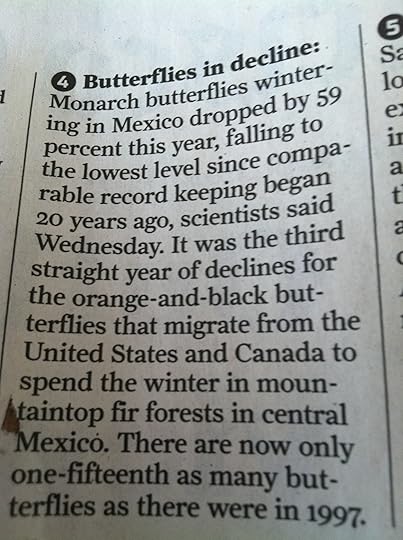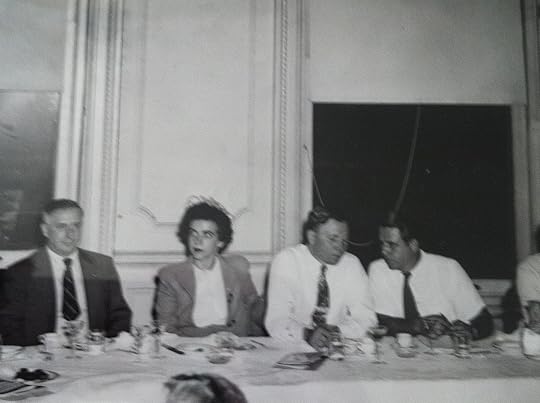Barbara Rhine's Blog, page 3
April 21, 2013
Barbara Kingsolver’s “Flight Behavior” soars!
The title is perfect on at least three different levels: 1) behavior of the butterflies; 2) behavior of Dellarobia Turnbow, who wants to flee her marriage; and 3) behavior of the media, and for that matter most of the human community, which prefers to fly away from the knowledge of climate change and its consequences.

Butterfly Habitat?

Butterfly Habitat?

Butterfly Habitat?
Our Dellarobia! You will laugh, you will flinch, you may cry, at our working-class housewife’s sexually-restless desperation as mother of two young children, wife of a man less inquisitive than she, and daughter-in-law of a mean-spirited woman who appears to pull all the strings. Dellarobia wants so much more, and on the level of fun fiction, this is the story what she gets and what she doesn’t.
Kingsolver uses Dellarobia and her cast of supporting characters masterfully to delineate the class difference between environmentalists and poor Christian rural farmers. And through Ovid Bryan, her Caribbean scientist who shows up to study the Monarchs butterflies, the author even manages to give us a believable scenario where for once class trumps race, even in the old South.
But the main thing about this book, whose real main characters are the Monarchs and climate change? Against all odds, the novel’s insightful exploration of our weather plight manages to be uplifting. It turns out that people care about butterflies, maybe even enough to do something (quickly!) about the impending ecological disasters that are lurking all around us.
Some say this book is preachy, and certainly the authorial view is clear throughout. But why is this criticism leveled most often at works that take on politics and point to the need for change? Is Nabokov’s Lolita didactic because he insists on showing us the internal workings of a pedophile? Do we call Fitzgerald to task for subjecting us to the travails of the upper class in The Great Gatsby, or is it just Steinbeck who is prescriptive, in The Grapes of Wrath, and In Dubious Battle?
Maybe it’s the Soviets’ fault! In their demand for socialist realism, did they ruin social realism for us all forever? Or does the incessant critique serve the interest of the status quo, by denigrating any call through fiction for substantive change?
In any event, if you want to scare yourself with a dystopic description of what California weather could be like in 2025, try TC Boyle’s A Friend of the Earth. And if you want to understand what it’s like to be a young Latina scientist drilling for ice cores, Carbon Dreams, by Susan M. Gaines, is well worth your while. But if you are only going to read one novel on climate change, make it Kingsolver’s Flight Behavior. She allows us to laugh and dream and worry about the politics of the issue, all at the same time.

Butterfly Habitat?
The post Barbara Kingsolver’s “Flight Behavior” soars! appeared first on Barbara Rhine.
April 20, 2013
Two good movies about progressive politics from times still fresh in memory:
1. No, starring Gael Garcia Bernal. Remember the 1973 U.S.-sponsored coup against Chile’s President Salvador Allende, the first and only elected socialist at the time in Latin America? Pinochet, the military strongman who came into power, killed and tortured thousands, and disappeared thousands more. His henchmen broke the bones in folk singer Victor Jara‘s hands, then executed him with others, in the Chile Stadium (re-named the Victor Jara Stadium in 2003). For those of us in the North American left movement, this coup felt very personal, as if it could have happened to us.
In 1988, finally, there was a referendum on Pinochet in Chile. Each side–pro or con on the Dictator– was allowed a sequence of fifteen-minute ads on nation-wide TV. This movie is about the “No” campaign. How to use that light bright commercial medium to get the military tyrant’s heel off the neck of the people? So much pain to convey; so much need for hope! Not a fast-paced film, but instead an authentic account of the aftermath of Pinochet’s damage, which, understandably, almost overwhelms the left’s ability to get the job done. Ah, but not quite, so Chile finally gets to move on to the post-modern mostly capitalist mess that characterizes our current time.
2. Ginger and Rosa, starring . During the Cuban missile crisis there were reports of how many millions would be lost in Europe if the U.S. and the Soviet Union had a nuclear exchange. As a young teenager I had spent sleepless nights after finishing books from my parents’ shelves about the bombing of Hiroshima, and the torture of Algerian guerrillas by the French. So I was primed for the nervous fear of nuclear annihilation that came just as I started college. My mother was so concerned that she came out of her political retirement to resume activism in the Women’s Strike for Peace, and that must have reassured me, because I don’t remember being as terrified as I should have been.
This movie takes us inside the British Ban the Bomb movement during this tense time, from the viewpoint of two sensitive young girls, one of whom is all too certain that everyone is going to die. They both struggle, not only with the fear of no future, but also with the internal dynamics of their families. Here the rough personal situation wreaks havoc, but at least no thermonuclear war, so that’s something to be happy about, innit?
Each film presents a detailed, persuasive reconstruction of a time gone by in a country other than the USA. The mature viewer remembers times and places that resonate with Shulamith Firestone’s truth: the personal is political. And, the reverse is also true. The political is personal as well.
The post Two good movies about progressive politics from times still fresh in memory: appeared first on Barbara Rhine.
April 19, 2013
Who is the Greatest Narcissist…
In TC Boyle’s The Women?
Narcissism is not in short supply in this book. The Great Architect, Frank Lloyd Wright, of course, was adept at both preoccupation with and promotion of self. And the three women who sacrificed their respectability to have him–all after he had six(!) children in his first marriage– were as involved with themselves as with their oft-absent lover.
But for absolute narcissist? The person absolutely lost in self, who can’t think or talk or understand anything else, and who has no insight into the havoc this wreaks? Miriam, the second of Wright’s three disastrous romantic entanglements, trumps them all.
Anger courses through Miriam like a river in flood, like a match put to tinder, like a lightning strike on water. Miriam changes from a believer in love without marriage into a harridan on behalf of her own marriage, which, since she lacks even a shred of remorse or self-knowledge, bothers her not one whit.
Remind you of anyone you know? If so, you will find this book compelling. Boyle describes Miriam with such care–even love if that’s possible with such a horrible person–that you may end up with insight into whoever has sucked you into their destructive sphere.
Also, if you are interested in what it was like to live when divorce was fault-based with a vengeance—when men and women alike were ruined if they followed their hearts out of unhappy marriages—you will be fascinated. If you want believable internal detail about three women who struggled for the freedom to do what they liked with their own lives, you will enjoy this book.

Born in 1914, a Feminist Teaches at a Left-Wing Camp
And for a bonus, through Mamah, Wright’s first great love, you will learn about Ellen Key, a Swedish feminist who explored female sexuality at the turn of the twentieth century.

Woman Unionist in a Male-Dominated World
Finally, if you care about what made Frank Lloyd Wright tick, you will know him better after you read this book.
An aside about the historical novel. After reading Russell Banks’ Cloudsplitter, I was shocked to discover that Lymen Epps, John Brown’s best friend, who died due to Brown’s son Owen in the book, in reality attended John Brown’s funeral! Call me crazy, but when a novel uses characters that existed in history, the author should be correct about the basic historical facts.
What makes the historical novel’s enterprise thrilling is that the fiction genre allows the inquiry to move inside the factual character’s heart and soul. This is why fiction, historical or not, is arguably the most accurate truth of all. So Banks apparently wanted to surmise that Owen fell in love with Epps’ wife, and/or had a gay attraction to Epps himself, and/or couldn’t handle black/white friendship. That’s fine, but why does it require having Owen kill Epps off? Banks is a compelling writer, but when I discovered all this, I was sorry I had read the book at all.
Re The Women, there are no such unpleasant surprises. Sure, the narrators, Tadashi Endo and Seamus O’Flaherty, are fictional, but they are not central to the action, so it’s fine. Also, duh. Fictional is fictional; there are no actual facts that matter. Not so with Epps. A human being deserves to have the date and manner of his death remain intact.
The three women who risked all to love Frank Lloyd Wright are amazingly real and alive in this book, and for that alone The Women is well worth the read.
The post Who is the Greatest Narcissist… appeared first on Barbara Rhine.



